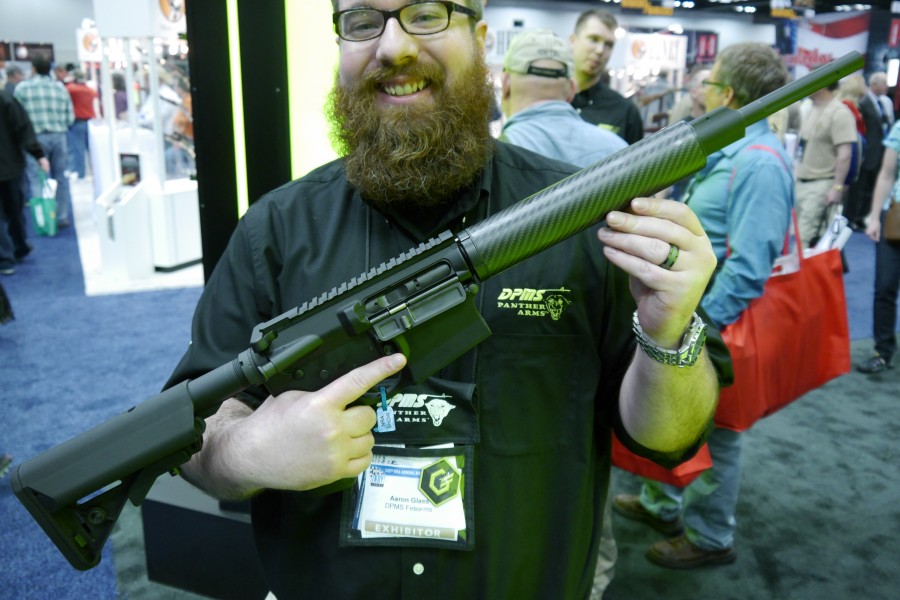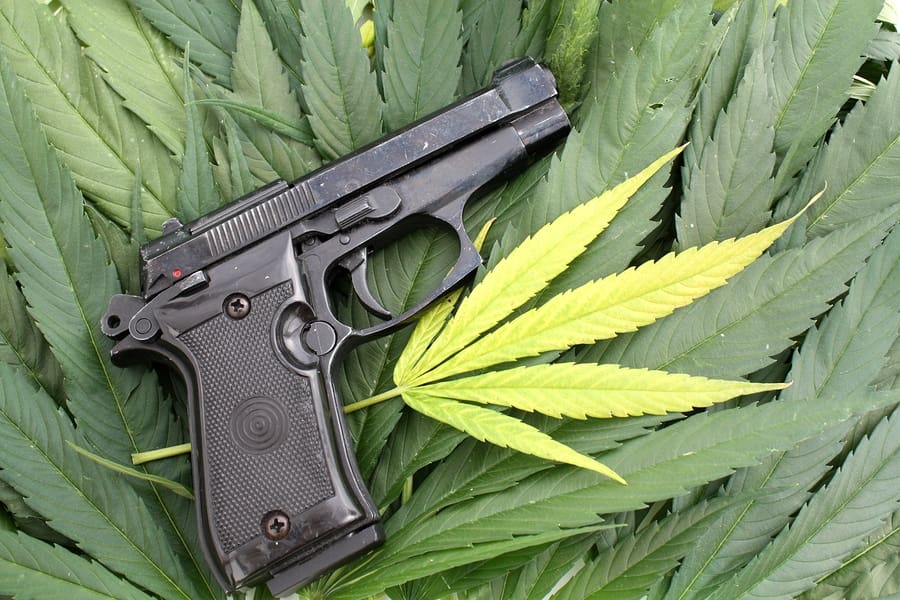DPMS’s AR-10 rifles are pretty popular largely because they’re an inexpensive alternative for those looking for a more powerful semi-automatic rifle. They’re accurate, too — there’s a pair of twin girls that use their DPMS .308 rifles to hit the 1,000 yard target at my local range with ease. Heck, they had to ask the range master to put up a smaller target to keep from getting bored. Now, DPMS has shortened their Hunter rifle and started offering it in a couple new calibers, namely .243 and .338. Oh, and MSRP is $1,699 — much less by the time it gets to the gun shop, naturally. It looks pretty sweet, and we’ll ask for one to test out.





An AR in .243, about time. I’m not even an AR guy and I would jump on one as a hunting/varmint rifle.
Not exactly a new thing. DPMS has been making these calibers in their 1st gen 308AR pattern for years. This is their 2nd gen platform though that trims weight and length. Honestly, they feel like handling a regular AR15, which is very cool.
Have to agree with Jeff above, Im curiously aroused by the possibility of an AR in .243 as it is one of my favorite hunting calibers along with .270.
Then again I guess this is just the other side of the spectrum from the guys who are making the .300 Win Mag AR.
Can’t hunt with semi in PA 🙁
You can, if you don’t get caught. lol
I have one of their LR308B rifles – 18″ bull barrel. NOT a hunting rifle at 12 lbs with the scope, but that sucker is a tackdriver with a 168gr match bullet.
I beg to differ! I hunt with the LR-308B every year. I’ve taken probably a dozen deer with it! It *is* a tack-driver!
I literally had dream last night that I was hunting deer in a field with my dad and friends. And one of those friends had a DPMS GII .308. I may trade out my 6.8 SPC AR for a 16″ .308 DPMS. I’m looking forward to the reviews. A lightweight semi auto .308 would be ideal to add to the collection.
The .338 Federal is an interesting cartridge choice as well for big game. I’m not sure how much industry support / popularity the round enjoys, but it shouldn’t be much of a problem for handloaders. The .338 Federal is to the .308 what the 300 BLK is to the 5.56.
This is what I’ve been waiting for…an all around AR suitable for longer range hog hunting as companion to trusty win70 in 270.
A81 can you remind us noobs the advantages of .338 for this?
Some great tips on this in past by Dyspeptic re: weight all- up w mag and scope. Have to search or maybe hd will weigh in too.
A necked-up cartridge typically exhibits gains in efficiency, momentum, and energy. The .338 Federal is a .308 Winchester necked up to take .338 caliber bullets. I’m know that the .338 Federal can push 180-210 grain bullets at sufficient velocities to exceed 3000 foot pounds in a 20″ barrel. The relatively short case to caliber limits bullet weight and length, but I don’t handload this cartridge and don’t have much experience with it. That means that the .338 caliber “sweet spot” regarding very high ballistic coefficients with 250-300 grain bullets can’t be achieved with the .338 Federal. I haven’t seen any factory loads with a bullet weight higher than 210 grains, so a G1 ballistic coefficient of around .450 or so. Factory ammo is ranges from about $1 to 2$ per round.
It’s pretty big for a hog round, but could definitely fit that bill. There are plenty of factory rounds available the last time I checked ammoseek.
I don’t think that you could push 3,000 fps out of a .338 Federal in a 20″ tube. I just don’t see it. I could be proven wrong, but my gut hunch (I’m away from my library of data right now) tells me it can’t be done without creating some ferocious pressures in the chamber.
I’m getting 3,000 (and a skosh) fps on a 210gr Nosler Partition out of my .338 WM, a Winnie Mod 70 with a 26″ barrel, using great hairy gobs more powder than a .308 case could dream of holding, and I’m seeing primers just start to flatten at that velocity – meaning my chamber pressure is “up there” in the 58K+ PSI region.
I don’t own a .338 Federal, but I’ve helped build up a .338-06 and with that larger (than a .308) case, 210’s were not quite able to achieve 3,000 fps.
When one starts getting into heavy bullets and high velocities, a long barrel and slow burning powders really help achieve higher velocities. Since the typical modern brass case doesn’t want to see more than about 63,000 psi, the only option you have to accelerate a really heavy pill is to keep the accelerating force on the bullet for longer, and that means a longer barrel. The requirement to keep up the force on the base of the bullet requires a slower-burning powder.
The Savage .250 started this obsession with breaking 3,000 fps MV’s, but there’s absolutely no requirement that any hunting rifle launch projectiles that fast. I’d remind people that the vast herds of bison in America were slaughtered predominately with a .50-70 or .45-70 round, which amble downrange at rather sedate velocities – but their bullets possess significant mass.
Meant to say FPE and not FPS. I’ve got a 14 month old running around the house getting into everything. 3000+ FPE and roughly 2700 FPS or so from a 20″ barrel with 180-185 grain bullets and around 2500-2600 with 210 grain bullets. Not sure on the velocity loss in a 16″ barrel, but if it follows the characteristics of the parent .308 Winchester and uses similar powders than it probably isn’t particularly sensitive to loss of barrel length.
Carbon fiber front tube on a hunting rifle? Hmmm, yea, I’ll give that a miss.
The single round that people should lust after in a package like this would be 7mm-08. .243 is nice, but only OK for hunting. The wide selection of 7mm hunting bullets have it all over the 6mm bullet offerings for big game hunting.
The .338 WM (or .338-06 or .338 Federal), .35 Whelen or 9.3×62 are great all-round hunting rounds for anything on the North American continent – and most of what you can find in Africa as well. Mid-30’s allows you to start flinging 250 to 300 grains downrange, which is where you can start to have some confidence vs. dangerous game.
I was under the impression that the 250 and 300 grain .338 bullets were too long to fit in a .338 Federal (parent cartride .308 Winchester) case. Feel free to correct me if I’m wrong.
You’re right – in the AR-10 or LR-308 (or whatever someone wants to call their AR-style .308 semi-auto) the heavier pills would be too long to fit into the magazine without setting them way down into the case. Brain fart on my part.
Another reason why, in hunting rifles, I don’t like semi-autos. When I want to use a particular bullet, I don’t like all the fol-de-rol that a semi-auto imposes on me. With a .338 Federal/-06 or WinMag, if the hunter is competent, there’s no reason or need for a second shot anyway, so the semi-auto issue is moot.
The 300gr .338’s have some of the more impressive Bc’s and SD’s out there, period. To do better, you’d have to go way heavier and larger or into very long 7mm pills or into the 220+ grain .30’s.
Hence my affinity for the .338 Lapua and the 7mm magnums.
The only .338 Winchester Magnums I’d want to buy are semi-autos (Browning BAR and Benelli R1), for two good reasons: dangerous game that often require multiple rounds, such as the largest bear species or bison (heck, I don’t think the 3-round magazines are large enough), and I want every reduction in recoil I can get for magnum rounds. I hear the R1 manages recoil better and I believe it, and it’s what I’d likely go with for that reason, but the BAR has a great track record of performance where it really counts: reliability and relatively good accuracy. I don’t know why you call the .338s great all-around North American cartridges. Yes, they’ll effectively kill any North American animal, but I consider them niche cartridges for big game, large elk and up, to include moose, brown bear, and bison. For deer, they’re a less practical choice. For medium game, something like a 7mm-08 would be ideal for most people’s shooting, and you can’t get more versatile than .30-06 which with proper bullet selection will serve a hunter from varmints to moose and grizzly bear.
I don’t know what you have against carbon-fiber handguards, either. I personally am no fan of round “hunter” handguards, but I love the light weight of carbon fiber if it’s done right. I’ve heard nothing but good things about Christensen Arms’ carbon fiber, for example.
Personally, I’ve been oscillating between .260 Remington or 6.5 Creedmoor and 7mm-08 for my dream “AR-10” (or whatever you prefer to call a modern .308-based AR). I’m tempted to go 6.5mm as it’s plenty adequate for deer and it seems competition target shooting has largely embraced 6.5mm, but I’m currently leaning toward 7mm-08 as, when it comes to numbers, .260 and 6.5 Creedmoor seem to offer a roughly similar ballistic coefficients and roughly similar lower ft-lbs of recoil, the latter of which surprised me. If there is a difference in BC or recoil in favor of 6.5mm, it appears to be close enough to be negligible. Judging from various recoil tables and calculators, very roughly (highly variable depending on the load, and felt recoil depends on the configuration of the rifle), for a rifle of about 8 lbs, .243 recoil energy seems to be around 8-9 ft-lbs, 7mm-08 and the 6.5s seem to be about 12-13 ft/lbs, and .308 16-18 ft-lbs. So, with 7mm-08 instead of 6.5mm I don’t give up anything significant in accuracy or the low amount of recoil (essential to me for rapid aimed fire), yet 7mm-08 is widely considered superior in terminal performance. Ammo availability (practice, match, and hunting) is superior for the older and more common 7mm-08 round. For target shooting Hornady A-MAX has a G1 BC of .625 in 7mm (against .585 in 6.5mm). At one point I considered .243 for it’s low recoil, but even on deer it’s a marginally effective round and I have little confidence in it’s stopping power at long range. Honestly, the performance I care about most in my intended rifle build is against armed men at 300-1000 meters. Compared to .308, lower recoil helps keep the rifle on target, and higher ballistic coefficients give it more energy at long range. Plus, ammo is lighter.
I feel like I’m at risk of talking out of my ass replying to a professional who generally knows what he’s talking about, so please don’t hesitate to tell me if I don’t know what I’m writing about.
What I have against carbon fiber on sporting guns comes down to this:
Chip or abrade the CF composite hard enough to break into the fiber. Run your hand or flesh over the exposed fiber. Enjoy the trip to the dermatologist or ER to get the fiber excised from your flesh after it gets infected. I love the engineering qualities and attributes of CF. I hate the issues it has with “real world” use near human flesh – especially my skin & flesh.
I live in Wyoming, so bears, elk, mountain goat, sheep, etc are on the list of animals I might hunt. One day, I intend to hunt Alaska as well. My experience is that “wicked fast” velocity, smaller pills tend to ruin more meat than a slower, heavier bullet that I can send through one or both front shoulders. I think that too many hunters obsess about making long shots, rather than competent shots at more credible ranges. When I shoot something with a .338 or .35 Whelen, it does down, DRT. OK, so they might not be as flat as “hotter” cartridges – so I get closer. That’s why I call it “hunting” instead of “sniping.”
I completely agree with you hunting shot ranges. Long-range shooting should be a rarely used hunting technique in the toolbox, no matter the animal. I see hunters risking not getting a clean kill in order to stroke their egos with a long range shot. It’s unethical. I am an enthusiast of long-range marksmanship, but generally the only things I’d shoot over 300 yards away are targets and, God forbid it ever comes to it, enemy combatants. Typical hunters that fire a box or two of ammo a year or less should really try to avoid long shots.
For big game, high velocity is often a hindrance rather than a help. As you said, it can destroy much meat. .45-70 works wonderfully on bears and bison. Because it’s slow and can be downloaded to a lighter load, it’ll work as a deer rifle without destroying a huge amount of meat like other powerful cartridges might. But Americans have a tendency to overgun, to the detriment of practice and accuracy. A .35 Remington will probably work just as well on deer and a less powerful cartridge has many benefits. You can get a decent high-value rifle for a few hundred bucks, and I’d advise the committed hunter to generally use different cartridges for different classes of frequently-hunted game, even if that means owning a handful of high-value, inexpensive rifles. A sledgehammer might be capable of pounding down every nail, but rather than depend on a magnum cartridge’s power it is far better to use an inexpensive round of adequate killing power that makes practicing cost-effective. A powerful round poorly placed will not do the job well.
I think you may be exaggerating the danger of chipping Cerakoted high-end carbon fiber furniture in most hunting scenarios. Still, carbon fiber is getting less and less attractive as a firearm material as there are now some pretty good alternatives hitting the marketplace. Keymod and M-Lok handguards are getting pretty damn good. I’m seeing some interesting magnesium-aluminum alloys, lighter than aluminum but plenty strong enough (and not prone to flaming up like magnesium), such as on BCM’s KMR Keymod forend.
Rifle aside where can a man get an introduction to these twins?
<_<
LOL! First gun in .338 Lapua with a FORWARD ASSIST! ROTFLMAO!
I guess I better up grade, ole sicom is a bit heavy, but shes my baby, sure love the caliber. Not a long shtr.
That rifle chambered in .338 Lapua would be a cannon….I can’t picture that round out of a 20″ barrel.
Well it’s a good thing it is chambered in .338 Federal then.
Nick, let me know what you will need. We will make it happen. [email protected]
Comments are closed.